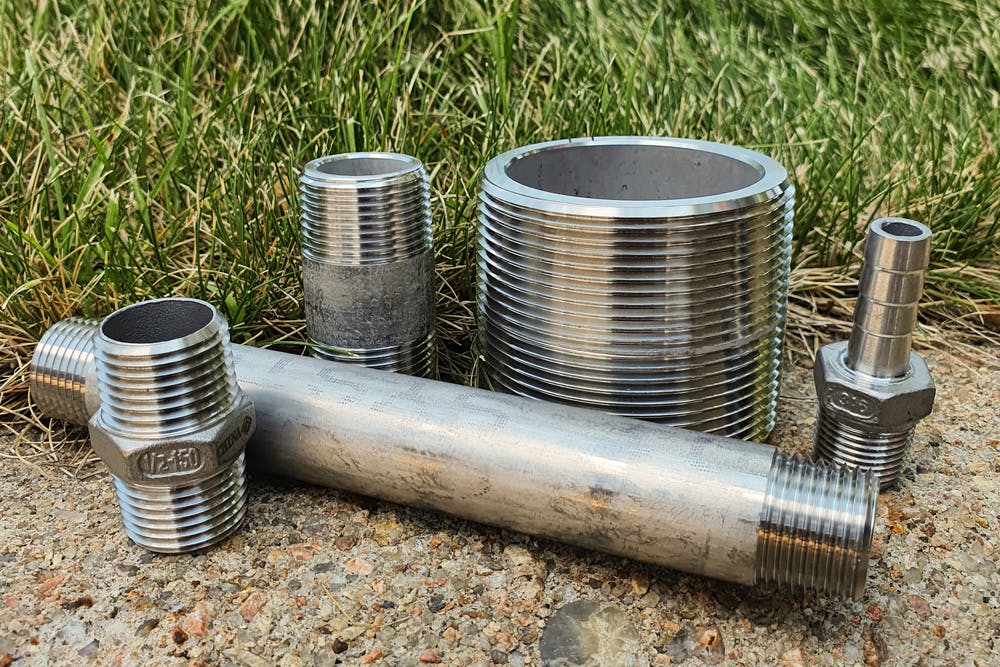Stainless Steel Nipples - Uses

Image Description: An image showing Titan Stainless Steel Adapters
A nipple is a short piece of pipe that is used as a fitting to connect piping in plumbing applications. Nipple fittings are produced in various materials, although stainless steel nipples are the most common due to their strength and durability.
Stainless steel nipples are usually made with male pipe thread (MPT) connections on both ends, connecting two separate female threaded pipes and fittings. The connection allows for a watertight seal between the fittings.
Stainless steel nipples are primarily used in low-pressure piping systems, and the type of nipple used will vary with the size, temperature, and working pressure of the system. Therefore, depending on the specific application, there are various types of pipe nipples to choose from. This article will outline the uses of different types of stainless steel nipples.
Stainless Steel Nipples - Uses
Different types of stainless steel nipples are designed for different uses and applications. While there is some potential overlap between different pipe nipples, each has specific design features that determine the most appropriate use.
Barrel Pipe Nipple
Barrel nipples are tapered NPT threaded on both ends and have an unthreaded section in the middle. These are some of the most common types of pipe nipples, and due to their inherent strength and easy-to-remove design can be used in various applications to fit female threaded piping together.
T.O.E Pipe Nipple
T.O.E stands for threaded one end. T.O.E pipe nipples have one threaded end and one non-threaded end. Unlike other types of T.B.E (threaded both end) nipples, these are not used to fit piping together and are commonly used as legs for oil tanks.
Close Pipe/Running Pipe Nipple
A close pipe nipple is a stainless steel nipple that does not have an unthreaded section in the middle. These types of pipe nipples are also known as running nipples. These pipe nipples are designed such that connected fittings come very close to one another, leaving very little of the pipe nipple exposed.
Generally, close or running pipe nipples are difficult to work with as they can easily become damaged upon removal unless specialty equipment is used.
Shoulder Pipe Nipple
Shoulder pipe nipples are longer than close nipples and have a very small section of unthreaded pipe in the middle. However, this unthreaded section is not large enough to fit a pipe wrench to remove the nipple.
Hexagonal Pipe Nipple
Also known as a Hex pipe nipple, these are designed with a hexagonal-shaped middle section. This allows one to securely grasp the nipple with a wrench to tighten or remove it. This design feature provides a greater mechanical advantage than that of a normally rounded nipple. Hence, hex pipe nipples are used in various applications where nipples need to be regularly removed or replaced.
Reducing/Unequal Pipe Nipple
Reducing or unequal pipe nipples are designed to allow a female fitting with a large connection to attach to a relatively smaller one. These are normally used for piping systems where a change in pipe dimension and flow pressure is necessary.
Hose Pipe Nipple
A Hose pipe nipple is designed with a male threaded connection on one end and a hose barb on the other end. These are normally used for piping systems that require a pipe to be connected to tubing.
Welding Pipe Nipple
A welding pipe nipple has a male threaded connection on one end and a standard cut pipe on the other end. Once the unthreaded end is welded and connected, fitting a pipe to the threaded end becomes much easier. Welding pipe nipples are normally used in piping systems that require welding to connect components.
Conclusion
Given that there are so many different types of pipe nipples and so many possible applications, choosing the right one can be rather confusing. The list of pipe nipple types above, along with their potential uses, should help you choose the correct stainless steel nipples for your piping system so that you can avoid leakages, inefficiency, or some damage.